In the early twentieth century and on the pastoral, religious and administrative frontiers of the Flinders Ranges, the Adnyamathanha and Nukunu people negotiated their way through a difficult cosmopolitanism. They negotiated with missionaries, pastoralists and police to preserve what autonomy they could in the face of guns, schools and sheep. At the South Australian Museum the Yurtu Ardla exhibition illustrates a carving movement that emerged on this cross-cultural frontier. Davy Ryan’s wooden shield is inscribed with rows of kangaroos and emus, a man atop a bucking horse and a heart inscribed with the words “God is Love” in a series of contradictory images of frontier life. Ryan is an avant-garde innovator here, folding the frontier’s competing ways of life onto the one shield, offering figures of identification for the different peoples passing through its missions and stations.
The exhibition adds to these historic items with newly commissioned piti (coolamon), thiparra (shields), wadna (boomerangs), yakadi (walking sticks) and wirri (clubs). The South Australian Museum describe these new works as a “continuation” and “revitalisation” of this art movement, but in truth its artists have barely paused.[1] The oldest of the living carvers is Roy Coulthard, who remembers Ryan and other artists from his boyhood in the 1950s and 1960s. Today Coulthard works with fellow artist Darryl Thomas to visit schools and share the Aboriginal history of the Flinders Ranges with young people. In his knowledge and enthusiasm for carving Coulthard became the energetic focus of Yurtu Ardla’s workshops.
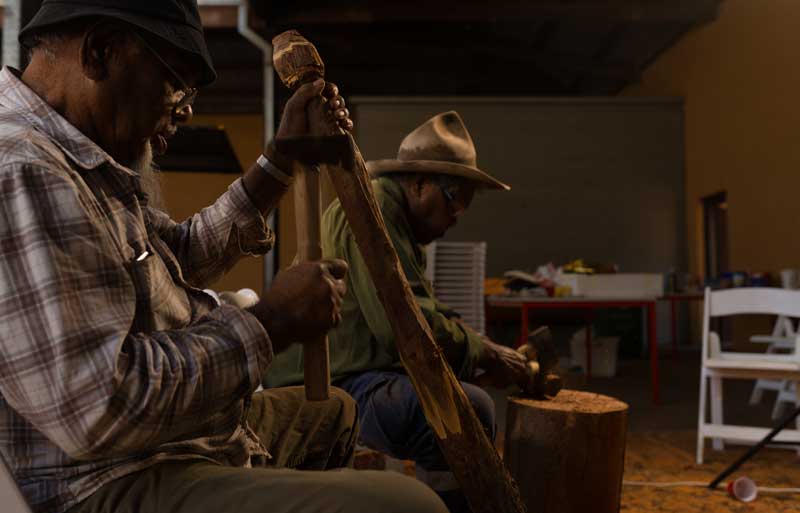
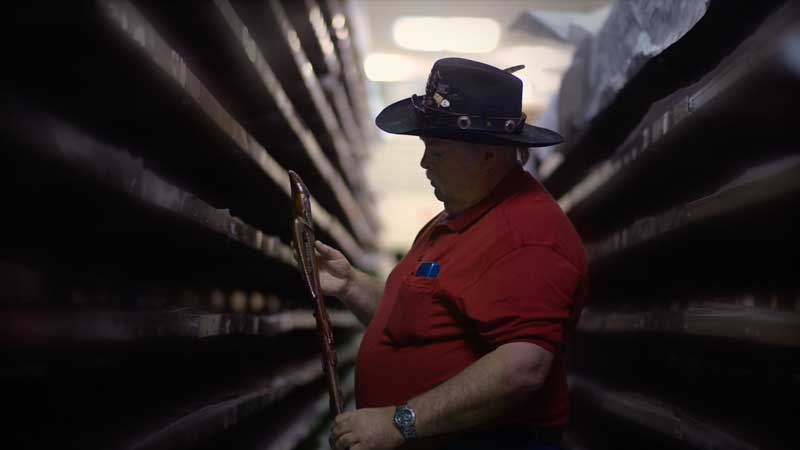
So it is that the exhibition features a beautifully incised club by Troy Wayne Dargan, magnificently hewn clapping wadna by Lawrie Fredrick Thomas, and work by the polymath Donny McKenzie, who not only carves but works with paint and glass in a Port Augusta studio. The relationship here is not only to history, but to the wood itself, to yurtu and ardla. In video interviews that are part of the exhibition, Clayton Cruse tells us that the wood chooses itself and tells him what to make, while the charismatic 21-year-old Dallas Brady says that he speaks to the wood as he carves it. Large portrait photographs of the artists dominate the exhibition, replacing the evidence-based museological approach to the work with an emphasis on the relations between the men and the material. The shapes of piti and wadna rely on the artists’ eyes for the shapes of mulga roots as much as the skills of the hand.
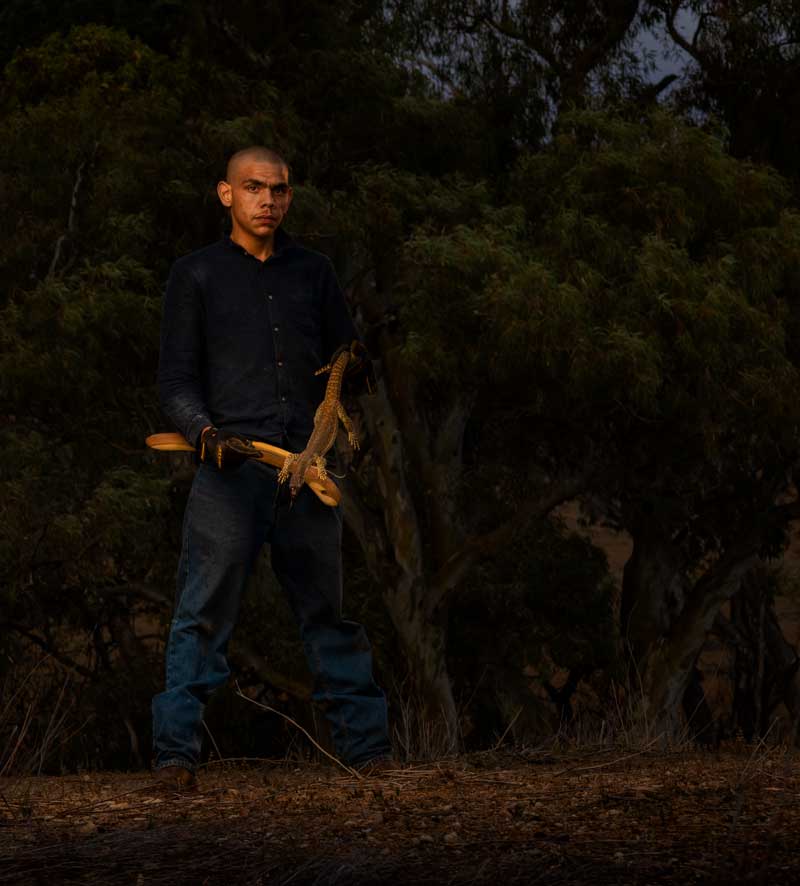
Roy Coulthard is living proof of the continuity of this entanglement, between the generations and as across the settlements of South Australia. His father Walter Coulthard was also a carver, while his grandfather Ted Coulthard was a pioneer of the cross-cultural trade in carvings between settlers and locals along the telegraph and railway lines of South Australia. Roy remembers his grandfather working through the cold nights at Nepabunna, seated by a fire in an old metal drum.[2] Nepabunna Mission, and places like Ooldea on the train line, hosted industries for the production of boomerangs, shields, spears and walking sticks. As Tom Roberts and Arthur Streeton were taking weekend painting trips to the Melbourne countryside, declaring themselves the first to make Australian art, Ted and the other carvers were founding a modern art movement with mulga.
Here Yurtu Ardla is of crucial importance in attributing a yakadi that dates before 1896 to Ted. Topped with the carving of a bird holding a snake in its talons, and insects and lizards on its staff, the stick is installed next to two others of similar style, with bird heads and poker-worked scales, both of which are known to be by Ted. The attribution raises new questions, as the stick was collected on the “Finke river, in the centre of the continent,” when Ted was an Adnyamathanha man from the south.[3] It may be that “Finke” might have been confused with Finke Creek, that lies near Nepabunna in the Flinders Ranges, it may have been that Ted travelled north along the new telegraph line to the busy, cross-cultural hub of Charlotte Waters in the early 1890s.
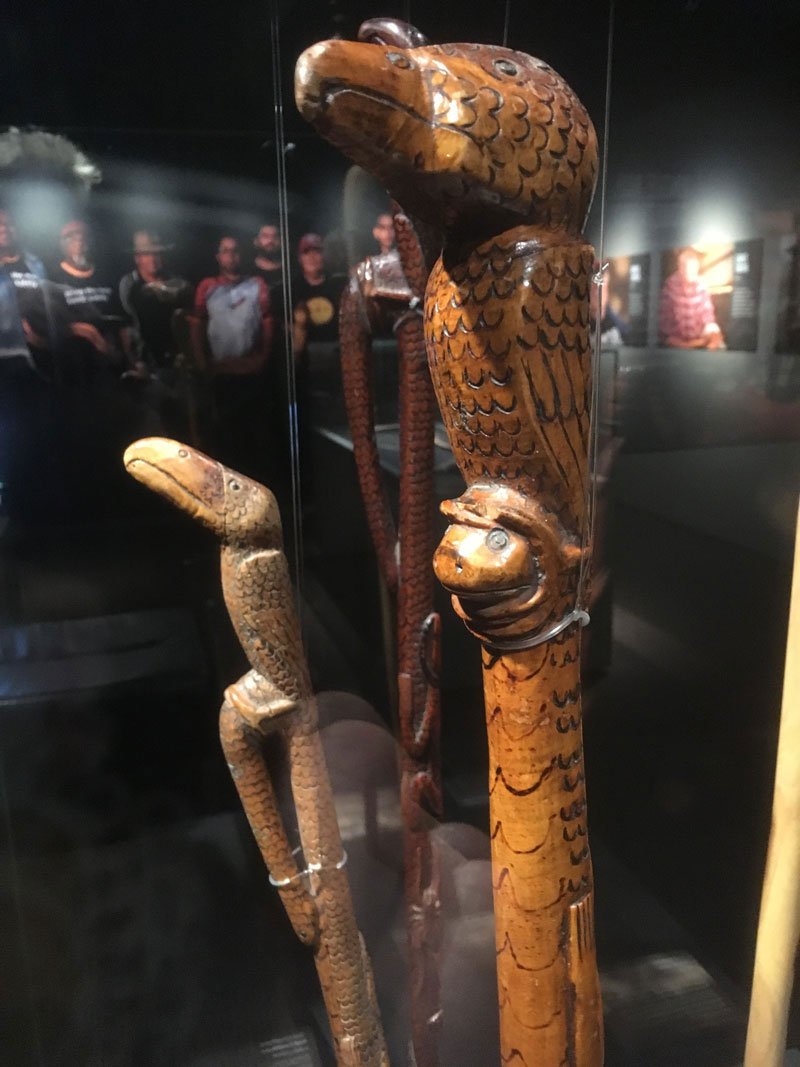
If the Museum has its attribution right, and I suspect they do, then they have gone a long way to personalising the origins of the “transitional” carving movement. Until now Jim Alyelkelhayeka Kite has been the star of early carvings from this region, his eclectic production of drawings, carvings and clay sculptures enlivened by an archive on his relationships with Spencer and Gillen, as well as with Herbert Basedow. John Kean has tracked stylistic continuities between Kite and Albert Namatjira’s carvings, while Jason Gibson reminds us that Kite was the first Aboriginal artist to have a solo exhibition in Adelaide in 1913.[4] Yurtu Ardla pushes the history of carvers back into the nineteenth century, establishing Ted at work before 1895 when the earliest known Kite carvings come from the twilight years of the twentieth century. While the walking stick is far from being the first piece of “transitional” carving in Australia, it is likely to be the oldest that has survived and the first whose artist is named.
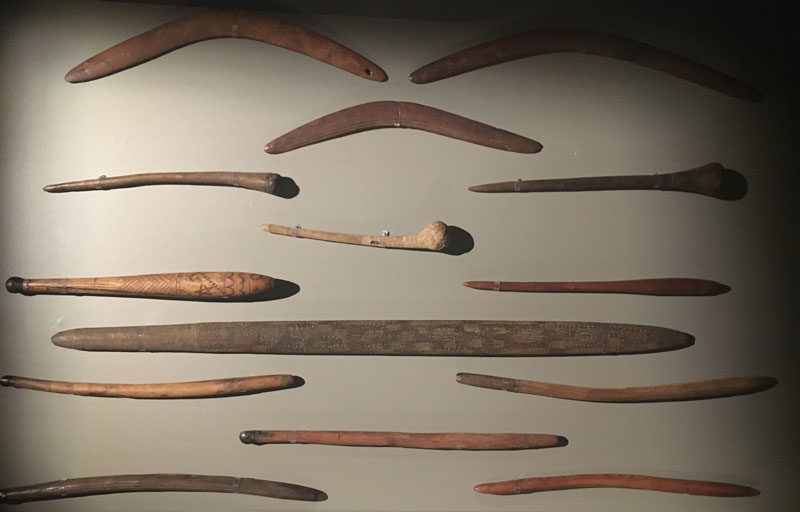
While all kinds of classical carvings were made for early colonists, especially boomerangs, shields and spears, the term “transitional” names artworks that show the shift from one cultural context to another. Such walking sticks were feted by the developing Adelaide aristocracy in a first wave of an “arts of acculturation” in which Indigenous artists were co-opted into the economies of the New World.[5] Terms like “acculturation” and “transitional” appear out of date today, but they imply the assimilation of artists into the New World.
Today the survival of Indigenous peoples and cultures makes it clear that these works are innovating within much longer histories. The adaptation of classical life to new forms and mediums is a kind of “transculturation,” in which art performs deeper logics of cosmological continuity.[6] Responding to this, the carved wooden fingers of Lynch Ryan’s yakadi appears like the intricate detail of a Church statue, carrying with it all the symbolism of the Staff of Moses, while also alluding to Dreaming stories of eagle and snake.
It is instructive to compare this individualisation of artistic accomplishment at the Museum to the salon-style display of an Adnyamathanha shield at the Art Gallery of South Australia next door. While Yurtu Ardla privileges living artists, with photographic and film media of the carvers alongside carvings, at AGSA this shield sits in the middle of a carved kangaroo and emu to make a mock Australian coat-of-arms. The kangaroo is likely by a settler, possibly from Bavaria, and dates to c. 1845, its juxtaposition with mulga carvings suggesting a bi-cultural Australia of artists both black and white, with local artists inspired by settler styles and settlers their enthusiastic collectors.
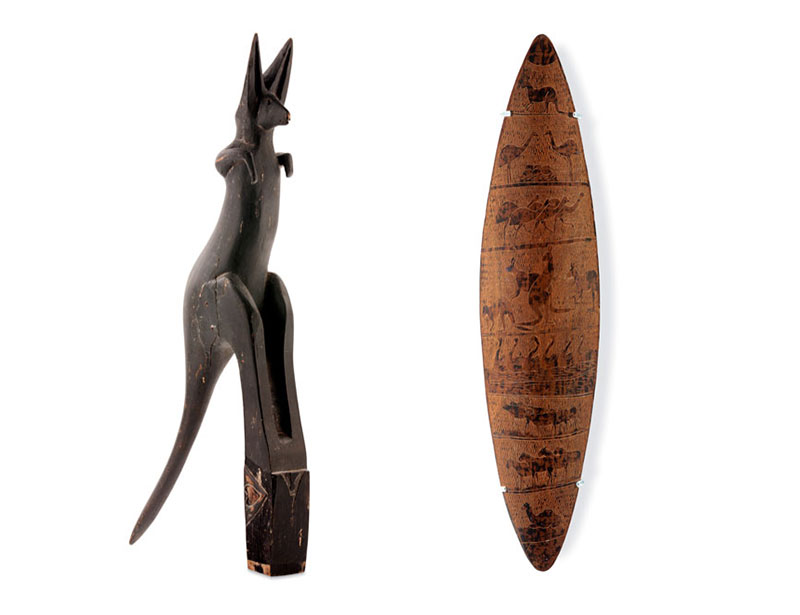
.jpg)
AGSA relies on the concept of a “Transitional shield” to give it a title, and while it is tempting to suggest replacing it with the more dynamic “transcultural,” it may be useful to ask the Adnyamathanha carvers from next door. This is likely to be another Davy Ryan piece, his expertise at animals here ballooning into an arcadian vision with emus and their eggs, swans, horses, cattle and a camel. It is fascinating to see the shield and animal carvings as part of the salon-style installation of the Elder Wing of the Art Gallery looking so much like the South Australian Museum's own faux-taxonomies next door.
While curator Lisa Slade has had a longstanding interest in the Wunderkammer, it may be that Adelaide was the only place in Australia that could engender such a radical exhibition design, with the precedent of the Museum’s archaic display of ethnographic clutter so much a part of Adelaide’s unconscious.[7] On its side, and with Yurtu Ardla, the South Australian Museum is adopting practices long established by art galleries, of naming artists and distinguishing works for their individual innovation rather than their ethnic identity.
The South Australian government is now committed to splitting its Museum into two, establishing a new National Gallery for Aboriginal Art and Cultures and a natural history museum on the older Museum site. Yet the lessons from the existing division between Museum and Gallery is that the distinction between art and museology, aesthetics and history, are intimately blurred. The Gallery is in need of actual ethnography to push its museological displays further, while the Museum wants to minimise its ethnographic displays to establish the historic significance of its artefacts.
North Terrace in Adelaide, where AGSA and SAM are situated, has been an innovative site for rethinking Australian art in recent years. The lesson from interstate has been that spectacular new buildings and restructured museums do not necessarily add innovation, and at times can have the reverse effect. Let's hope that throwing a new building at this concept of an Indigenous museum doesn’t overwhelm the potential of such projects as Yurtu Ardla to rewrite Australian history.
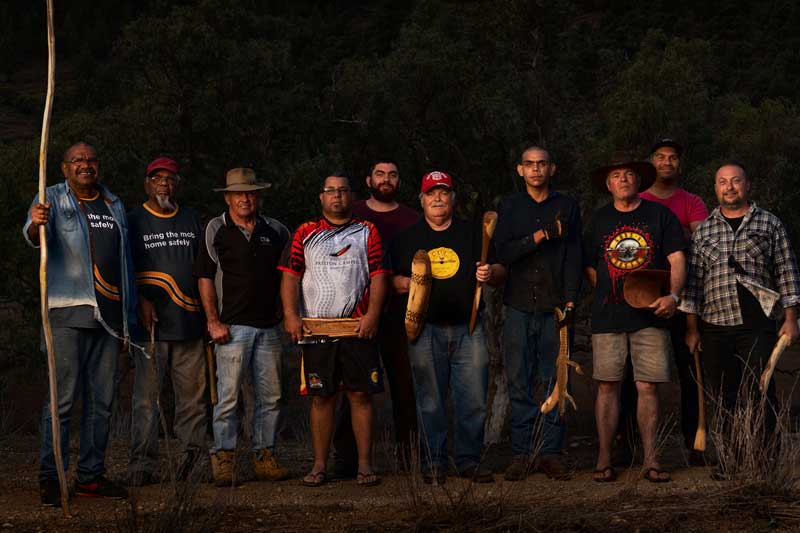
Footnotes
- ^ See http://www.samuseum.sa.gov.au/explore/exhibitions/yurtu-ardla.
- ^ Personal communication between the author and Roy Coulthard, 15 March 2019.
- ^ Thomas Worsnop, “Prehistoric Arts, Manufactures, Works, Weapons, etc, of the Aborigines of Australia,” C. E. Bristow, Government Printer, Adelaide, 1897, p. 46.
- ^ See John Kean, Paper presented at the Reimagining Australia conference, Perth, 8 December 2016; Jason Gibson, “John McDougall Stuart Remembered in Central Australia” in Scots under the Southern Cross, ed. Fred Cahir, Alison Inglis and Anne Beggs-Sunter, Ballarat Heritage Press, 2015, pp. 41–52 at 50; and Gibson, “Factotum and Friend: Anthropologists, Informants and Ethnographic Exchange and Central Australia,” History and Anthropology, 7 March, 2019.
- ^ The phrase “arts of acculturation” comes from Nelson H. H. Graburn, “Introduction,” Ethnic and Tourist Arts, University of California Press, Berkeley, 1976, p. 5.
- ^ See Ian McLean, Rattling Spears, Reaktion, London, 2016, especially chapter 2, pp. 35–49.
- ^ For example, in Curious Colony: A Twenty-First Century Wunderkammer, curated by Lisa Slade, Newcastle Region Art Gallery, 10 July – 29 August 2010.













